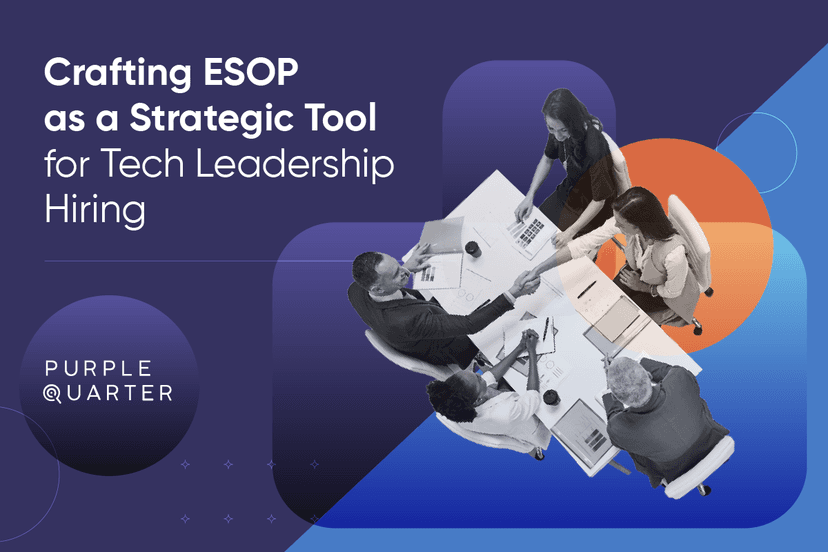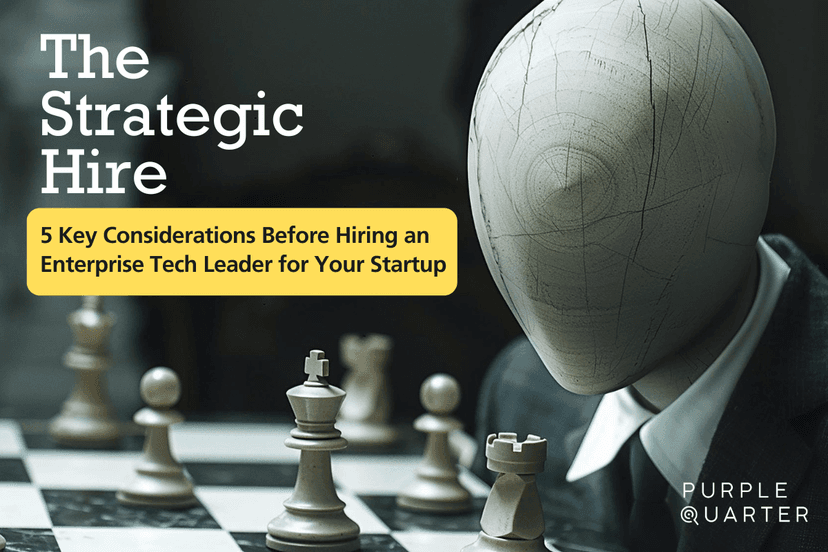Featured Articles
Subscribe to Our Newsletter
Receive exclusive updates and insights directly in your inbox.
Receive exclusive updates and insights directly in your inbox.

While several Indian companies like Zerodha, Urban Company, Razorpay, and Swiggy have successfully created wealth for their early employees through structured ESOP buybacks, many startups still treat ESOPs primarily as a retention tool rather than a true wealth-building opportunity. ⚠️ The fine print often hides critical loopholes—board approvals for exercising options, lack of liquidity events, investor-first clauses, and tax complications. Without clarity, what seems like a lucrative equity package can turn into an uncertain, locked-in promise. ⛔ If<a href="https://www.purplequarter.com/crafting-esops-as-a-strategic-tool-for-tech-leadership-hiring/leadership-advisory/"> ESOPs form a significant part of your compensation package</a>, dear tech executives you should treat them with the same scrutiny as your base salary. ✅ Here are key questions you should ask before signing the offer: 💰 How do I get paid? Are there clear timelines for exercising options? 💸 Is there a clear path to liquidity? Will there be secondary sales, buybacks, or an IPO timeline? 📉 What happened to past employees’ ESOPs? Did they realize actual value, or were their options forfeited? 📜 Do I need board approval to sell my shares? If yes, under what conditions? ⚖️ What are the tax implications? Will I face tax burdens at the time of exercise, sale, or both? 🚪 What happens if I leave the company? How long do I have to exercise my vested options? 🔄 Is there anti-dilution protection? Will my ownership get diluted during future funding rounds? <h3 data-start="0" data-end="65"><strong data-start="4" data-end="63">The ESOP Paradox—Ownership Without Control?</strong></h3> <p data-start="67" data-end="354">While ESOPs promise a stake in the company’s success, they often come with hidden constraints—from long vesting periods to unpredictable liquidity events. The real question is: Are you an "owner" in the true sense, or just holding conditional stock that you may never cash out?</p> <p data-start="356" data-end="548">Before signing, consider this: <strong data-start="387" data-end="467">Would you invest your own money under the same terms as your ESOP agreement?</strong> If the answer is no, it’s time to renegotiate—or rethink the offer altogether.</p> <p data-start="550" data-end="682" data-is-last-node="" data-is-only-node="">True wealth isn’t just about having equity—it’s about having the power to realize its value. Make sure your ESOPs give you both.</p> <h3>Authored by Soumi Bhattacharya</h3> For more information, reach out to the <a href="mailto:marketing@purplequarter.com">Marketing Team</a>
Read More
<p>For women in leadership generally, stepping away—even briefly—can mean stepping off the radar. The scene of senior women tech leaders is further cutthroat. While junior roles are supported with structured returnee programmes, senior positions often remain out of reach, as if to suggest leadership skills have an expiry date. </p> <p>But does a sabbatical or a break really erase years of expertise? Here we dig into why leadership re-entry remains elusive, the programmes changing the game, and how women techies can reclaim their place at the top.</p> <h2><b>The Landscape: Why the Leadership Gap Persists</b><b></b></h2> <p> </p> <h3><b> 1. The Technical Knowledge Paradox</b></h3> <p>Senior women in tech face a unique challenge not present in other leadership domains: they must simultaneously demonstrate executive leadership capabilities while proving their technical relevance hasn't diminished during their absence. This creates a paradoxical situation where the returning leaders have to spend significant time reestablishing technical credibility before their strategic insights are valued, creating an additional barrier to effective leadership</p> <p>Some companies are addressing this by implementing "technical relevance" versus "technical recency" frameworks in their hiring processes.</p> <p><ul></p> <li style="font-weight: 400;" aria-level="1">Strategically highlighting their architectural and systems thinking knowledge, which ages more gracefully than specific technology implementations</li> <li style="font-weight: 400;" aria-level="1">Demonstrating their ability to evaluate and integrate new technologies rather than hands-on coding proficiency</li> <li style="font-weight: 400;" aria-level="1">Leveraging technical adjacency - showing how their knowledge in one domain transfers to emerging areas</li> <p></ul></p> <h3><b> 2. Age + Gender + Tech: The Intersectionality Challenge</b> </h3> <p>Returning women tech leaders face a unique triple bias intersection:</p> <p><ul></p> <li style="font-weight: 400;" aria-level="1">Gender bias in tech leadership remains persistent, with women techies holding only 28% of leadership roles</li> <li style="font-weight: 400;" aria-level="1">Tech's youth-oriented culture creates age bias, particularly pronounced for those with career gaps</li> <li style="font-weight: 400;" aria-level="1">The "currency bias" assumes technological skills degrade rapidly during absence</li> <p></ul></p> <p>This intersectionality creates complex barriers that standard returnship programs fail to address.</p> <p><img class="alignnone size-large wp-image-152178" src="https://admin.purplequarter.com/storage/posts/67fe300fed2c8-Women-in-Tech_Infographic-1024x576.jpg" alt="Image" width="1024" height="576"></p> <h2><b>Actionable Insights for Women Tech Leaders Returning to Boardroom </b><span style="font-weight: 400;"> </span><b></b></h2> <h3><b> 1. The Entrepreneurial Bridge</b></h3> A growing trend among senior women in tech is leveraging entrepreneurial ventures as stepping stones back to corporate leadership. This <b>"founder-to-executive" pathway </b>transforms a potential career gap into a strategic advantage: <p><ul></p> <li style="font-weight: 400;" aria-level="1">Develops fresh perspectives on market needs, customer pain points, and technology deployment </li> <li style="font-weight: 400;" aria-level="1">Provides demonstrable evidence of current business acumen and decision-making capability and demonstrates comfort with risk and ambiguity</li> <p><li style="font-weight: 400;" aria-level="1">Builds fresh networks outside existing corporate structures</p> <b></b><b></b></li> <p></ul></p> <h3><b> 2. Beyond Mentorship: Sponsorship Networks</b> </h3> The distinction between mentorship and sponsorship is critical for returning women tech leaders. Mentors provide advice and guidance; sponsors actively advocate for opportunities and advancement. Research indicates that <b>women with sponsors are 23% more likely to advance in their tech careers after a break</b> than those with mentors alone. The most effective sponsorship models for returning tech leaders include: <p><ul></p> <li style="font-weight: 400;" aria-level="1">"Board-level sponsorship" where corporate directors advocate for returning leaders</li> <li style="font-weight: 400;" aria-level="1">"Capability vouching" where respected technical leaders publicly endorse the returning leader's judgment</li> <li style="font-weight: 400;" aria-level="1">"Opportunity creation" where sponsors carve out specific roles aligned with the returning leader's strengths</li> <li style="font-weight: 400;" aria-level="1">"Skill translation" where sponsors help frame career break experiences as valuable perspectives</li> <p></ul></p> <p>Successful returning leaders are strategically building sponsorship constellations - networks of advocates across different organizational levels and domains who can support their re-entry and advancement. </p> <h3><b> 3. Global Programmes and Policies Supporting Leadership Comebacks</b></h3> <p>Several countries and organizations have introduced initiatives specifically targeting women techies:</p> <b>United States</b> <p><ul></p> <li style="font-weight: 400;" aria-level="1"><b><i>Path Forward</i></b><b>:</b> Collaborates with tech companies like Amazon, Intuit, and Meta to offer returnships tailored for senior professionals. </li> <li style="font-weight: 400;" aria-level="1"><b><i>ReBoot Accel</i></b><b>:</b> Provides executive training and leadership workshops for women returning to senior tech roles. </li> <li style="font-weight: 400;" aria-level="1"><b><i>iRelaunch</i></b><b>:</b> Partners with tech giants like Apple and IBM to facilitate mid-career internships and returnship to the mainstream. </li> <p></ul></p> <b>Middle East</b> <p><ul></p> <li><b><i>Dubai Women Establishment (DWE</i></b><b>):</b> DWE collaborates with tech firms to provide leadership returnships and mentorship programmes for women leaders returning to the workforce.</li> <li aria-level="1"><b><i>GLOW by Deloitte: </i></b><b>Growth & Leadership Opportunities for Women (GLOW)</b> is the Deloitte Middle East’s gender diversity ambition that fosters inclusivity through mentorship, sponsorship and allyship. <b>Returnity</b> – one of its flagship programmes is designed to support women returning from parental leave. </li> <p></ul></p> Read <a href="https://www.purplequarter.com/how-the-middle-east-is-building-an-inclusive-tech-ecosystem/all-about-tech/">how the Middle East is closing the gender gap and building an inclusive ecosystem</a>. <b>India</b> <p><ul></p> <li style="font-weight: 400;" aria-level="1"><b><i>Accenture Career Reboot</i></b><b>:</b> Gives women returnees the chance to interact with industry experts and Accenture’s leadership team.</li> <li style="font-weight: 400;" aria-level="1"><b><i>HCL’s Career Re-Begin</i></b><b>:</b> Focuses on experienced women professionals, ensuring they return to positions matching their prior seniority. <i> </i></li> <li style="font-weight: 400;" aria-level="1"><b>Capegemini’s Relaunch:</b> Aimed at women who have taken a career break from 18 months to 10 years, this 6-month programme offers the opportunity to join the Capegemini workforce in senior positions. </li> <p></ul></p> <h2><b>Time for a Reboot: Purple Quarter Enabling Leadership Re-Entry </b></h2> <p>At Purple Quarter, we recognize that career breaks don't diminish leadership potential. Our proprietary Behavioural Metrics Model (BMM) evaluates candidates based on:</p> <p><ul></p> <li style="font-weight: 400;" aria-level="1"><b>Technical Expertise:</b> Ensuring returning leaders are equipped for modern tech challenges.</li> <li style="font-weight: 400;" aria-level="1"><b>Change Potential:</b> Assessing adaptability post-career break.</li> <li style="font-weight: 400;" aria-level="1"><b>Motivational Fit:</b> Aligning leadership roles with individual aspirations.</li> <li style="font-weight: 400;" aria-level="1"><b>Cultural Fit:</b> Matching leaders with organizational values.</li> <p></ul></p> <p>The second stint doesn’t have to stall a leadership career for women. With the right programmes, policies, and mindset, women tech executives can seamlessly re-enter leadership roles, bringing diverse perspectives and invaluable experience to the table.</p> <i>Ready to navigate your leadership return journey? Connect with us - </i><a href="mailto:interact@purplequarter.com"><b><i>interact@purplequarter.com</i></b></a> <p> </p> <h3>Authored by Soumi Bhattacharya</h3> For more information, reach out to the <a href="mailto:marketing@purplequarter.com">Marketing Team</a>
Read More
<p>Every founder wants crème de la crème tech leaders. And every tech leader wants meaningful equity. But here’s the catch — <b>most ESOPs are structured to look lucrative, not actually be lucrative</b>. A rigid four-year vesting plan? It might work for mid-level hires, but a seasoned CTO knows better. Equity with no clear liquidity path? That’s not wealth—it’s a waiting game with no exit in sight. Misaligned performance metrics? They might reward revenue growth but ignore the actual impact.</p> <p>The reality is, <b>tech executives evaluate ESOPs differently than other employees.</b> They know the tax traps, the dilution risks, and the red flags in vesting schedules. So, if your ESOP isn’t structured right, it won’t attract the kind of leader who can take your company to the next level. In this article, we break down the biggest ESOP mistakes companies make—and what actually works to turn stock options into a real wealth-building incentive for top-tier tech executives.</p> <h2><b>Avoiding ESOP Pitfalls: 5 Proven Strategies to Attract & Retain Tech Executives </b></h2> <h3><b> 1. Strategic Vesting Plans</b></h3> <p>Standard vesting models don’t always align with the company’s growth trajectory. A steep vesting schedule might discourage long-term commitment, while a long cliff period could deter sought-after executives.</p> <p><b>📌 Best Practice:</b> Use flexible vesting approaches that align with business goals:</p> <ul> <li style="font-weight: 400;" aria-level="2"><b>Milestone-based vesting</b>: Tied to measurable goals like achieving an ARR milestone or launching a new product.</li> <li style="font-weight: 400;" aria-level="2"><b>Front-loaded vesting</b>: A higher percentage of equity vesting in the early years to reward high-impact executives.</li> <li style="font-weight: 400;" aria-level="2"><b>Rolling vesting plans:</b> Unlike a "cliff vesting" plan where all shares vest at once after a specific period, this plan distributes ownership incrementally over time, often resulting in a higher retention rate.<br> </li> </ul> <h3><b style="color: #993300;"> 2. Clear Liquidity Mechanisms</b></h3> <p>Many startups offer ESOPs without a clear exit strategy. If there’s no near-term IPO plans or acquisition in sight, and no secondary buyback program, these stock options may not attract senior tech leaders.</p> <p><b>📌 Best Practice:</b> Provide multiple liquidity options:</p> <ul> <li style="font-weight: 400;" aria-level="2"><b>Secondary sales</b>: Allow executives to sell a portion of their vested shares pre-IPO.</li> <li style="font-weight: 400;" aria-level="2"><b>Structured buyback programs</b>: Companies like Flipkart and Swiggy implemented buyback rounds in 2023 and 2024 respectively to maintain ESOP attractiveness.</li> <li style="font-weight: 400;" aria-level="2"><b>Exit clarity</b>: Define scenarios like mergers, acquisitions, or IPOs where ESOPs can be monetized.<br> </li> </ul> <h3><b> <span style="color: #993300;">3. Optimized Tax Planning</span></b></h3> <p>Poor ESOP structuring can create significant tax liabilities for executives, diminishing their attractiveness. For instance, in India, ESOPs are taxed twice – at the time of exercise and again while selling shares. In the US, executives often prefer <b>Incentive Stock Options (ISOs)</b> over <b>Non-Qualified Stock Options (NSOs)</b> due to favourable tax treatment. ISOs allow employees to potentially pay lower capital gains tax rates when selling the stock, provided certain conditions are met. In contrast, NSOs are taxed at ordinary income tax rates upon exercise, which can result in higher immediate tax liabilities. Global leaders working across jurisdictions may face cross-border tax complications. </p> <p><b>📌 Best Practice:</b> Implement diverse variable pay methods: </p> <ul> <li style="font-weight: 400;" aria-level="2">Offer <b>RSUs (Restricted Stock Units)</b> with time-based, milestone-based, or composite restrictions to increase retention rate. </li> <li style="font-weight: 400;" aria-level="2">Utilize <b>trust-based ESOP</b> structures that provide senior leaders with ownership in the company through a trust structure, which manages the shares on their behalf, allowing for easier administration and tax advantages. </li> <li style="font-weight: 400;" aria-level="2">Implement <b>Share Appreciation Rights [SAR]</b> which is usually offered at a base price and when exercised, the executives receive the difference between the grant price and market price, often in the form of cash or shares. <b>Phantom Stocks</b>, a SAR-equivalent especially used by private or pre-IPO firms, where executives receive cash equivalent to the appreciation in share value without actually owning shares, paid usually at a liquidity event.<br> </li> </ul> <h3><b> 4. Long-Term Vision Alignment</b></h3> <p>ESOPs should incentivize leadership to drive sustained business impact, not just reward tenure. If the vesting schedule doesn’t align with key milestones—such as a planned IPO, acquisition, expansion, or profitability targets—tech leaders may lack motivation to stay the course. </p> <p><b>📌 Best Practice: </b>Align ESOP structures with business growth plans:</p> <ul> <li style="font-weight: 400;" aria-level="2"><b>For IPO-bound companies:</b> Ensure vesting schedules coincide with public listing timelines.</li> <li style="font-weight: 400;" aria-level="2"><b>For M&A-focused firms:</b> Implement accelerated vesting upon acquisition to incentivize leadership retention.</li> <li style="font-weight: 400;" aria-level="2"><b>For founder-driven startups:</b> Structure ESOPs to minimize dilution while still attracting elite talent.</li> <li style="font-weight: 400;" aria-level="2"><b>Fractional tech leaders or interim CXOs</b>: Offer shorter vesting schedules or milestone-based equity.</li> <li style="font-weight: 400;" aria-level="2"><b>Early-stage vs. late-stage companies</b>: Early-stage firms may grant higher equity, whereas late-stage companies balance ESOPs with cash incentives.<br> </li> </ul> <h3><b> <span style="color: #993300;">5. Create Industry-Standard ESOP Pool </span></b></h3> <p>An ESOP pool is a portion of a company’s equity set aside specifically for issuing stock options to employees. It represents the number of shares allocated for the ESOP, typically making up a small percentage of the company's total equity. </p> <p><b>📌 Best Practice:</b> Set up an ESOP pool and ensure that equity is allocated effectively across various roles. Here is a benchmark suggested by Antler – an early-stage VC firm: </p> <p><img class="alignnone size-large wp-image-152147" src="https://admin.purplequarter.com/storage/posts/67fe30125167e-ESOP-Infographic-1-1024x576.png" alt="ESOP best practices - ESOP Pool - industry benchmarking " width="1024" height="576"></p> <p>While these guidelines provide a direction, the specific needs of your company, the industry, and the seniority of the hires may warrant adjustments. Tailoring equity packages to reflect the unique contributions of each tech leader will ensure both fairness and long-term retention. As companies scale, ESOP pools typically expand, making it essential to monitor the ESOP policy regularly.</p> <h2><b>Analysing ESOP from A Tech Leader's Perspective </b></h2> <p>For tech leaders, it's crucial to navigate the fine print of ESOPs carefully. Common loopholes include board approvals for exercising options, lack of liquidity events, investor-first clauses, and complex tax implications. If ESOPs form a significant part of the compensation package, tech executives should treat them with the same scrutiny as their base salary. Key considerations include a clear path to liquidity—whether through secondary sales, buybacks, or an IPO timeline—along with post-resignation exercise windows and robust anti-dilution protection. <a href="https://www.purplequarter.com/esopguidefortechexecutives/leadership-advisory/">Here's. detailed guide to decode ESOP as a salary component</a>. </p> <h3><b>Closing Thoughts </b></h3> <p>Ultimately, while tech leaders must approach ESOPs with due diligence, it's equally on companies to design plans that inspire confidence, not caution. <a href="https://www.linkedin.com/in/kiran-satya-39543115/?originalSubdomain=in">Kiran Satya</a>, Regional CEO, India & MEA, Purple Quarter puts it: </p> <blockquote><p><strong><i>“ESOPs should be a growth engine, not a waiting game. The best equity plans offer clear liquidity, milestone-based vesting, and real value—anchored in execution, not just ideas. If your ESOP doesn’t excite a tech leader, it’s not built right.”</i></strong></p></blockquote> <p>ESOPs were once a simple promise—but the traditional playbook no longer works. Liquidity is no longer a ‘someday’ event, tax inefficiencies can’t be ignored, and a one-size-fits-all vesting model is a deal-breaker.</p> <p>Tomorrow’s tech leaders won’t just look at ESOPs as an add-on to their salary; they’ll demand structures that match their risk, impact, and long-term vision. Could we see more dynamic equity models—customized vesting based on individual contributions? More secondary market liquidity options to give executives real financial upside? More AI-driven benchmarking to ensure fairness in equity distribution? Time will tell. </p> <p>For more insights on structuring ESOPs and understanding compensation benchmarks for your tech leadership team, speak to our experts at <a href="mailto:interact@purplequarter.com"><b>interact@purplequarter.com</b></a>.</p> <p> </p> <h3><strong>Authored by Soumi Bhattacharya</strong></h3>
Read More
<h3><b><span style="color: #353260;">The Macro Landscape Shaping Tech Executive Hiring</span></b></h3> <p>The era of easy capital and breakneck expansion is fading. It is 2025 and businesses are shifting gears—from hyper-growth at all costs to sustainable, strategic scaling. This shift isn’t just reshaping business models; it’s redefining what companies expect from their tech executives. Leaders who once thrived in rapid expansion now need to navigate financial constraints, optimize resources, and drive profitability. </p> <p>Meanwhile, advancements in quantum computing, Web3, and AI-first solutions are pushing companies to seek executives who understand AI-driven decision-making and can integrate automation into business operations. </p> <p>Additionally, governments worldwide are tightening regulations on data privacy, AI ethics, and cybersecurity – making compliance-first leadership a priority for businesses navigating complex regulatory landscapes. The resurgence of cryptocurrency is further reshaping the political and financial landscape. With increased institutional adoption, evolving regulations, and geopolitical shifts influencing digital asset policies, the demand for tech leaders with deep expertise in blockchain, decentralized finance (DeFi), and regulatory compliance is surging. </p> <p>The playbook for hiring tech leadership is being rewritten—are you ready for what’s next?</p> <p><img class="alignnone size-large wp-image-152125" src="https://admin.purplequarter.com/storage/posts/67fe3014dc838-TEHP-Infographic-1-1024x576.png" alt="Image" width="1024" height="576"></p> <h2><b>Key Hiring Trends for Tech Executives in 2025</b></h2> <h3><b style="color: #993300; font-size: 16px;"> 1. The Rise of Hybrid Tech Leaders</b></h3> <p>Traditional tech roles are merging with business leadership functions. In 2025, companies actively seek hybrid leaders who understand technology and product strategy.</p> <p><ul></p> <li style="font-weight: 400;" aria-level="1"><b>The CTO-CPO Hybrid:</b> Organizations want tech executives who can own both product development and technical execution, making the CTPO role increasingly popular.</li> <li style="font-weight: 400;" aria-level="1"><b>The Chief AI Officer:</b> AI-driven companies are appointing dedicated AI leaders who focus on strategy, ethics, and implementation of AI solutions at scale.</li> <p></ul></p> <h3><b style="color: #993300;"> 2. Shift from Traditional Hiring to Behavioral & Capability-Based Assessments</b></h3> <p>Businesses are moving away from evaluating executives solely based on past experiences and resumes. Instead, there is a growing reliance on behavioral assessments and data-driven evaluation models.</p> <p><ul></p> <li style="font-weight: 400;" aria-level="1"><b>Psychometric Testing:</b> Companies are using in-depth psychological assessments to evaluate leadership style, adaptability, and decision-making abilities.</li> <li style="font-weight: 400;" aria-level="1"><b>AI-Powered Hiring Tools:</b> Advanced AI algorithms help recruiters analyze candidates’ problem-solving approaches, leadership dynamics, and culture fit beyond just technical skills.</li> <p></ul></p> <h3><b> 3. Tech Executives as Growth Catalysts</b></h3> <p>Tech executives are no longer just responsible for software delivery; they are becoming key players in business growth.</p> <p><ul></p> <li style="font-weight: 400;" aria-level="1"><b>Board-Level Influence:</b> Tech leaders are taking on more strategic roles, often influencing company-wide decisions beyond engineering.</li> <li style="font-weight: 400;" aria-level="1"><b>Revenue Impact:</b> Companies are increasingly hiring CTOs and tech leaders based on their ability to drive revenue and business transformation, not just technical proficiency.</li> <p></ul></p> <h3><b> 4. The Remote vs. On-Site Leadership Debate</b></h3> <p>While remote work was normalized post-pandemic, 2025 is seeing a shift in expectations for tech executives.</p> <p><ul></p> <li style="font-weight: 400;" aria-level="1"><b>Declining Fully Remote Leadership Roles:</b> More companies are pushing for in-office leadership to foster collaboration and innovation.</li> <li style="font-weight: 400;" aria-level="1"><b>Hybrid Team Management:</b> As companies expand their engineering capabilities remotely, tech executives are expected to effectively manage distributed teams, ensure seamless collaboration, and maintain operational efficiency across time zones and geographies. </li> <p></ul></p> <h3><b> 5. Compensation Trends & The Shift in Equity Structures</b></h3> <p>Tech executive compensation is shifting from high fixed salaries to more performance-driven incentives.</p> <p><ul></p> <li style="font-weight: 400;" aria-level="1"><b>Variable Pay:</b> Companies are structuring executive pay with more performance-linked bonuses and long-term incentives.</li> <li style="font-weight: 400;" aria-level="1"><b>Equity-Based Compensation:</b> Startups and enterprises alike are restructuring equity distribution to attract and retain top leadership talent by aligning their success with business growth.</li> <p></ul></p> <h2><b>Smart Hiring is the New Power Move</b></h2> <b> Traditional Hiring is Dead. What’s Next?</b> <p>Conventional hiring methods, relying on industry connections and static job descriptions, are no longer sufficient. Companies need a more dynamic and strategic approach to finding the right talent.</p> <h3><b> Future-Proofing Leadership Hiring Strategy</b></h3> <p>To secure the right tech leadership in 2025 and beyond, companies must:</p> <p><ul></p> <li style="font-weight: 400;" aria-level="1"><b>Adopt data-driven hiring strategies</b> that go beyond traditional resumes.</li> <li style="font-weight: 400;" aria-level="1"><b>Invest in leadership development programs</b> to groom internal talent for executive roles.</li> <li style="font-weight: 400;" aria-level="1"><b>Leverage executive search partners</b> with deep insights into the evolving tech landscape.</li> <p></ul></p> <p>The hiring landscape for tech executives in 2025 is shifting towards a more strategic, data-driven, and results-oriented approach. Businesses must recognize the importance of hiring leaders who are not just tech experts but also visionaries capable of driving growth, navigating global trends, and ensuring long-term business success.</p> As the industry evolves, partnering with specialized <a href="https://www.purplequarter.com/">tech executive search firms</a> can be a game-changer. Companies that adapt to these hiring trends will not only secure the best leadership talent but also position themselves for sustainable innovation and competitive advantage in the years ahead. <p> </p> <h3>Authored by Soumi Bhattacharya</h3> For more information, reach out to the <a href="mailto:marketing@purplequarter.com">Marketing Team</a>
Read More
<p>What happens when a leader steering the ship at a billion-dollar enterprise steps into the fast, unpredictable waters of a startup? The potential for growth is immense—but so are the risks. From scaling systems to navigating regulatory hurdles, enterprise tech leaders bring valuable expertise, but how do you evaluate if they’re built for the chaos, agility, and impact-driven culture that startups demand? </p> Let’s find out. <h2><b>When is an Enterprise Tech Leader the Right Fit for a Startup?</b></h2> <img class="size-large wp-image-152039 aligncenter" src="https://admin.purplequarter.com/storage/posts/67fe301a44cba-Blog-Cover-1-1024x683.png" alt="hiring an enterprise tech leader" width="1024" height="683"> <ol> <li> <h3><b> Scaling Complex Systems</b></h3> </li> </ol> If your startup is <b>transitioning from MVP to a scalable product</b>, an enterprise leader’s experience can be invaluable. They’re used to building reliable, high-availability systems and managing the complexities of scaling infrastructure to support millions of users. A 2023 study found that <b>70% of startup products fail to scale effectively</b> because of poorly designed systems. Enterprise leaders bring the discipline to avoid such pitfalls. <ol start="2"> <li> <h3><b> Navigating Regulatory and Security Challenges</b></h3> </li> </ol> Compliance and security are non-negotiable in industries like fintech, healthtech, or edtech. Enterprise leaders often have expertise in <b>managing regulatory frameworks</b> and awareness of implementing security best practices. According to PwC, startups that implement robust security protocols in their early stages are <b>60% less likely to face cyber threats</b>. <ol start="3"> <li> <h3><b> Creating Sustainable Efficiency </b></h3> </li> </ol> Startups thrive on agility, but as teams expand, a lack of structure can lead to inefficiencies and, at times even chaos. Enterprise leaders are adept at introducing processes that <b>enhance productivity without stifling creativity</b>. <b>Key Scenarios:</b> Scaling engineering teams, introducing sprint frameworks, or optimizing cross-functional collaboration. <ol start="4"> <li> <h3><b> Expanding to New Markets or Geographies</b></h3> </li> </ol> If your startup is eyeing global expansion, enterprise leaders bring a wealth of experience in <b>managing distributed teams</b> and understanding <b>diverse market dynamics</b>. They can also leverage their enterprise network to accelerate go-to-market efforts. A study by First Round Capital revealed that 60% of startup leaders believe the biggest advantage of working in a startup is the ability to create impact quickly. Watch <a href="https://www.youtube.com/watch?v=UvUndvqJm_A&t=53s">Ajit Narayanan, CTPO, Licious, explore his journey from well-established enterprises to the budding D2C startup</a>. <h2><b>Evaluating Enterprise Leaders’ Potential </b></h2> While enterprise leaders bring significant experience, startups must evaluate them carefully to ensure they’re cultural and strategic fit. Here’s how:Before Hiring an Enterprise Tech Leader for Your Startup <ol> <li> <h3><b> Assessing Adaptability to Ambiguity</b></h3> </li> </ol> Startups operate in a world of uncertainty, where <b>priorities shift weekly</b>. Enterprise leaders are often accustomed to structured environments. Assess whether they can thrive in ambiguity and operate with agility. <b>Red Flag:</b> Over-reliance on large teams or extensive resources to achieve goals. <ol start="2"> <li> <h3><b> Evaluating Entrepreneurial Spirit</b></h3> </li> </ol> Startups require leaders who think like entrepreneurs—<b>proactive, resourceful, and hands-on</b>. While enterprise leaders may excel at scaling, assess their ability to take ownership of early-stage challenges. A 2022 survey by CB Insights showed that 43% of startups fail due to a lack of entrepreneurial mindset in their core leadership team. <b>- Pro Tip:</b> Evaluate how they prioritize initiatives with limited resources. Also, analyze if they have ever taken a project from 0 to 1. <ol start="3"> <li> <h3><b> Measuring Alignment with Startup Culture</b></h3> </li> </ol> Culture fit can make or break a hire; this is especially true when it comes to leadership hire. Startups often have <b>flat hierarchies and fast-paced decision-making</b>. Leaders who are used to corporate hierarchies may struggle. <b>- Cultural Fit Indicators:</b> Willingness to wear multiple hats, openness to direct feedback, and ability to collaborate across non-traditional roles. <b>- Actionable Tip:</b> Include team members from various levels in the interview process to gauge chemistry. <ol start="4"> <li> <h3><b> Evaluating Leadership Style</b></h3> </li> </ol> Enterprise leaders are often strong managers but may lack the mentorship approach most startups need given their accelerated growth. How they inspire and upskill junior teams is the cornerstone of leadership. Assess their previous stints and look for instances where they’ve empowered emerging leaders or enabled teams from scratch. <ol start="5"> <li> <h3><b> Testing Strategic Vision and Long-term Thinking</b></h3> </li> </ol> Startups need leaders who can think beyond the next sprint; vision clarity is prerequisite. Enterprise leaders looking to make their startup leap should demonstrate the ability to execute the startup’s immediate and long-term needs. Ask them to critique your current tech stack or roadmap. Are their insights both strategic and actionable? <b>- Red Flag:</b> Overemphasis on long-term plans without considering short-term execution. <h2><b>Trust the Experts </b></h2> Hiring an enterprise tech leader can be transformative for a startup—but only if the timing, role, and cultural alignment are right. By balancing the strengths of enterprise leaders with the agility of startup culture, a leadership team capable of navigating both the uncertainty of today and the scale of tomorrow can be built. At Purple Quarter, we have unlocked success for various startups – <a href="https://www.purplequarter.com/from-fintech-giant-to-gaming-startup-a-strategic-leadership-move-at-sportsbaazi/case-studies/">placing an AVP of Engineering at a gaming startup [SportsBaazi] from fintech giant [Bharatpe]</a>, moving a CTO from Walmart to a fintech startup Zolve. How did we do it? Our proprietary <a href="https://www.purplequarter.com/our-approach/">Behaviouaral Metrics Model</a> (BMM) made the decision making easier. It helped us assess the leaders’ tech agility, intellectual potential, logical reasoning, aspiration, change potential and culture fit. Want to find the leadership fit for your company? <a href="https://www.purplequarter.com/contact/">Reach out to us</a>. <h4></h4> <h4>Authored by Soumi Bhattacharya</h4> For more information, reach out to the <a href="mailto:marketing@purplequarter.com">Marketing Team</a>
Read More
You've raised millions, assembled a brilliant team, and your product is disrupting the market. But what if we told you a silent killer is gnawing away your company's potential, costing you millions in hidden expenses? <b>Spoiler alert</b>—it's not your marketing budget, your tech stack, or even your product! It's something far more fundamental—and far more fixable. <h3><b>When Talent Meets Strategy: The Leadership Equation Most Companies Miss</b></h3> The Leadership Multiplier Effect: A Gartner study reveals that companies with exceptional tech leadership see 3.5x faster revenue growth compared to their competitors. <b></b> <h3><b>➢ The Hidden Cost of Overlooking Your Most Critical Asset</b></h3> Let's do the math: <p>- Assuming an average tech company valuation: $50M</p> <p>- Overall Leadership impact on company performance: 30-40% [source: HBR] </p> - Hence, potential value at stake: $15M - $20M annually<b></b> <h3><b>➢ Real-world Leadership for Transformation</b></h3> <ul> <li><b>Werner Vogels at Amazon</b></li> </ul> As Amazon's long-standing CTO, Werner Vogels pioneered revolutionary cloud architectures that enabled microservices and serverless computing. His technical vision directly contributed to creating Amazon's cloud ecosystem, which now powers over 40% of the internet's cloud infrastructure. Vogels' leadership transformed how companies conceptualize and implement scalable technology infrastructure.<b></b> <ul> <li aria-level="1"><b>Padmasree Warrior at Cisco </b></li> </ul> As Cisco’s former Chief Technology & Strategy Officer (CTSO), Padmasree Warrior was instrumental in aligning the company’s technological advancements with its overarching business strategy. Warrior oversaw the integration of new business models, incubated cutting-edge technologies, and nurtured a pipeline of world-class technical talent, solidifying Cisco’s position as a global leader in networking and connectivity. Forbes recognized her as one of "The World's 100 Most Powerful Women" for three consecutive years. <h3><b><img class="alignnone wp-image-151926" src="https://admin.purplequarter.com/storage/posts/67fe301e3a49c-Blog-infographic-recruitment-3-1024x1024.png" alt="founders bleeding money without realising" width="679" height="679"></b></h3> <h3><b>➢ </b><b></b><b>Now, The Million-Dollar Question: Are You Settling or Selecting?</b></h3> Treat your next tech leader hire as your strategic inflection point—imagine a visionary who transforms a nascent blueprint into breakthrough performance, turning organizational challenges into competitive advantages. This isn't about filling a role. It's about finding a leader who can: <ul> <li style="font-weight: 400;" aria-level="1">Accelerate product development</li> <li style="font-weight: 400;" aria-level="1">Drive technological innovation</li> <li style="font-weight: 400;" aria-level="1">Reshape organizational culture</li> <li style="font-weight: 400;" aria-level="1">Unlock hidden market opportunities</li> <li style="font-weight: 400;" aria-level="1">Act as a talent magnet </li> </ul> The path to exceptional leadership isn't luck. It's a precision process that combines deep industry insight, strategic talent mapping, and cultural alignment. Think of it as organizational alchemy—turning potential into pure performance. <h3><b>Want all these minus the headache? Enters Purple Quarter!</b></h3> What do we do? We ensure that your next tech leaders don't just manage—they reimagine what's possible. <a href="https://www.purplequarter.com/scaling-success-should-mid-to-late-stage-startups-hire-big-tech-pros-or-startup-techies/leadership-advisory/">Hire the right fit </a>and feel the difference between incremental growth and market disruption. <h3>Authored by Soumi Bhattacharya</h3> For more information, reach out to the <a href="mailto:marketing@purplequarter.com">Marketing Team</a>
Read More